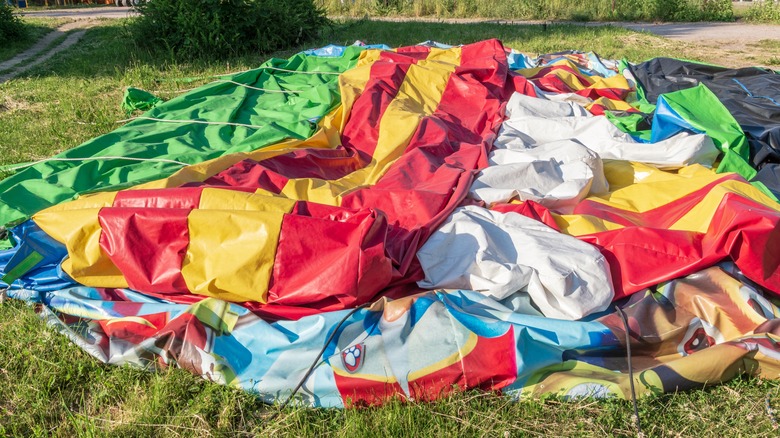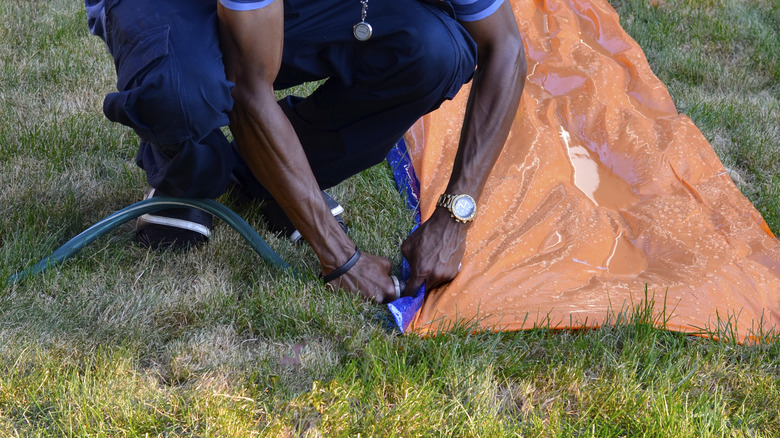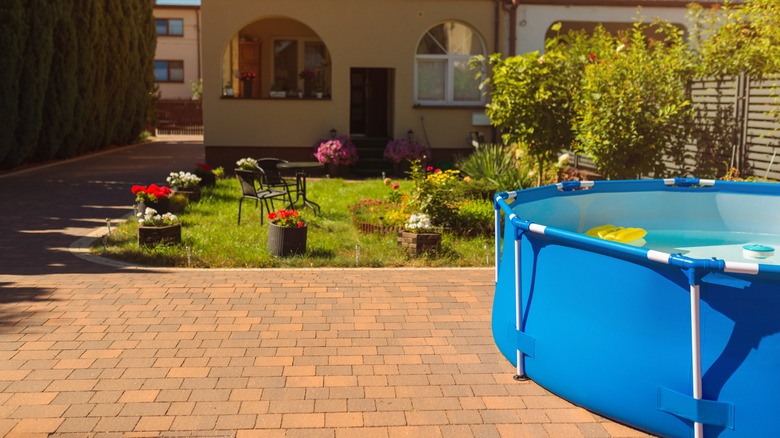How To Make Your Grass Bounce Back After Using Inflatables This Summer
Summer heat drives all of us into our backyards, whether to lounge in a hammock or splash about in a wading pool. The problem is, Slip N Slides are notorious grass ruiners. As are bounce houses, that staple of warm weather birthday parties, and even blow-up Jacuzzis. To ensure your lawn looks just as good after playtime's over as it did before, you likely attempt to avoid complete destruction by regularly moving yard toys around to different spots and watering and brushing the grass right after use. If yours ends up wrecked regardless, you can try watering it to rehydrate it or, in worst-case scenarios, reseed or even re-sod the area. The lawn is the surface of choice for many homeowners inflating summer-fun pools or castles. It's flat, generally free of debris, and considered safe for kids.
While it might seem like common sense to try to protect your grass by placing items underneath your inflatable, lawn care specialists claim that's a myth. Placing a big, flat inflatable object, especially one filled with water, on a patch of lawn blocks the sun, air, and water from reaching it. Grass is a plant, after all, and it needs ample amounts of those natural resources just to survive, let alone thrive. In fact, grass will start to show signs of distress, turning yellow or brown, within a few days. The weight of a kid-filled bounce castle or water-filled pool bearing down on the grass blades doesn't help matters, either.
Inflatable toy best practices for leaving a lawn in mint condition
First and foremost, always choose somewhere flat and shady to set up your inflatable yard toy — the underlying grass heats up too much in full sun. Move the play item to a completely different area of your backyard every 12 to 24 hours. You might be able to drag small filled swimming pools, but large ones are a different story. Emptying and refilling a pool often wastes a lot of water. Remember, the sun moves throughout the day, so watch its path closely, and move the toy if it ends up in a sunny spot later in the day. Where wading pools and inflatable Jacuzzis are concerned, dumping bucket loads of water onto your lawn in one go can also cause damage since waterlogged lawns struggle to thrive.
You'll cause a considerable amount of harm if you've added any pool chemicals to the water. So, instead of simply tipping the pool over once you're done with it, consider investing in an electric sump pump — Walmart has one by PROSTORMER for just over $50 — to pump the water out of the pool and into a nearby storm-water drain, for example. Bonus: These lawn care tips go a long way toward keeping your kiddie pool clean all summer long, too. After you've packed away or moved your inflatable toy, lightly water the area on which it sat (unless you're certain it's going to rain) and brush crushed blades with a stiff-bristled broom to help them stand up again or mow the area to encourage new growth.
Replace the grass or change the surface under your inflatable
The type of grass in your lawn matters, too. It might seem a bit extreme, but if you're experiencing constant damage from wading pools, Slip N Slides, or bounce houses and plan to use them often throughout the warmer months or to keep them set up for multiple days at a time, consider re-sodding your lawn with a tougher turf species. Bermuda grass is a good choice, or you could consider using shade-tolerant carpetgrass in your yard. Seeding a new lawn or laying roll-out turf might have to wait until the next season, though. The standard advice is to lay grass seed after the first frost. Follow the lawn care best practices for using inflatables outlined above until that time. Also consider replacing the real lawn with artificial turf. It drains well and it's easy to keep it looking fresh with this simple maintenance tip.
Another option available to all homeowners looking to preserve their hard-won lawn is setting up the inflatable somewhere indestructible that isn't your grass like your paved patio, concrete driveway, or even a large wooden deck. Place a foam or rubber mat, outdoor rug, old blanket, or artificial turf underneath the toy to give kiddos' feet a soft landing as they run and jump and to protect the base of the inflatable. Alternatively, opt for a water table over a flat-bottomed pool, splash pad, or bounce castle; those legs keep it off your precious grass.



